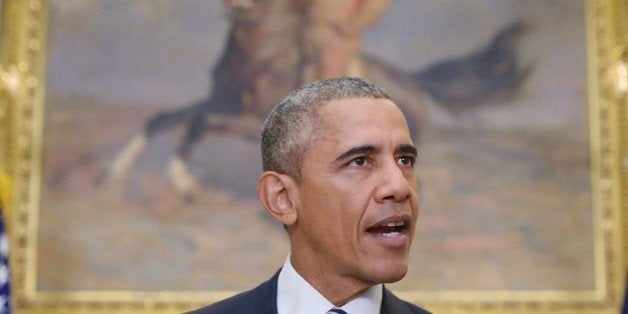
In the United States the saying goes that politicians often lead from the rear. Our elected "leaders" actually follow the crowd more often than they lead, charting their course with poll numbers rather than principles. That can be the sign of a healthy democracy where the popular vote matters more than the moneyed interests. However, once in a while a politician steps forward and truly leads, moving the country where it needs to go even though many don't see it yet. Obama's rejection of the Keystone pipeline is exactly one of those rare moments.
Obama not only rejected Keystone, he did it in the face of polls saying that a majority of Americans support the pipeline. He did it undaunted by the power of the fossil fuel industry. He did it strongly and loudly. And most importantly he made it clear that the rejection was about saving our climate.
Obama used the moment to deliver perhaps the most important message that any leader can send about climate change: the time to act is now. Most Americans support action on climate change, but they don't see it as a top priority. Poll after poll shows that Americans see climate change as a distant threat for the future. In poll after poll, Americans rank climate change last among the issues our leaders should tackle now.
But the science and the economics tell a very different story. America, and the world, must make a dramatic course change, and we must begin that correction right now. The path we choose to travel over next 5-15 years will determine our future. We have to start reducing emissions now, and we must eventually bring them all the way down to zero by mid-century. Carbon pollution doesn't wash out of the atmosphere; it only builds up. Warming will only get worse over time. We can put out only so much carbon pollution before warming becomes catastrophic. There is no going backward. We have a budget and we're eating it up fast.
However, at this moment, we're still at a place where we can easily avoid the worst impacts of climate change. We can make the transition to zero pollution with ordinary effort if we immediately stop investing in fossil fuel infrastructure and instead direct all new investment into renewable energy. That's the easy glide path, the path that not only avoids the worst impacts of climate change but also builds our economy. Renewable energy is not only clean; it's now the cheaper choice going forward. Due to the dramatic transformation of the energy industry over the last 10 years the prices for wind and solar have plummeted through the floor. Clean energy is now competitive, if not outright cheaper, than fossil fuels for most activities.
On the other hand, if we stay on the business as usual course, in just 10-15 years we will have blown through our remaining budget and we will then be faced with only bad options. At that point our choices will be simple. We could stay the course and face truly cataclysmic impacts of global warming. Or we could desperately attempt to halt most emissions by turning off our fossil fueled energy sources much, much faster than we could possibly replace them with clean energy. And in doing so we would crash dive the global economy.
The fork in the road is clear. From now on, every dollar we spend on new fossil-fuel infrastructure is simply throwing good money after bad. Even the World Bank has concluded that we have all the pipelines and power plants we need in order to burn through all the fossil fuel we can while staying in our carbon budget. From now on, every pipeline, every export terminal, every gas-fired power plant we start building will have to be shut down before it reaches the end of its useful life.
In contrast, every dollar we invest in wind and solar power means even cheaper energy down the road. Clean energy has pulled even with fossil fuel as the cheapest energy source. And the price of wind and solar will only get even cheaper as investments scale and technology improves because the fuel is always free.
In rejecting Keystone Obama put a bright light on that fork in the road. And he put spotlight on a very clear, bright line: no more investments in fossil-fuel infrastructure. No more throwing good money after bad.
Throwing light where there is darkness is a hallmark of leadership. And in America we are blessed to still have those kinds of leaders.
